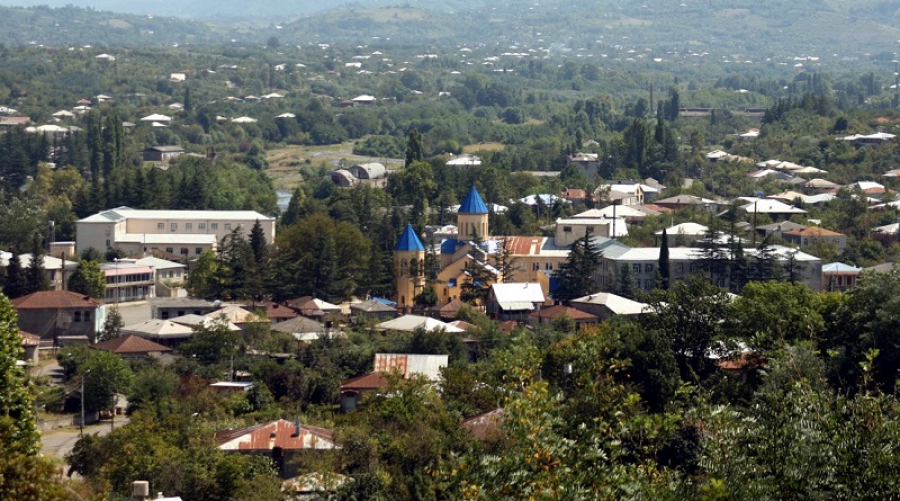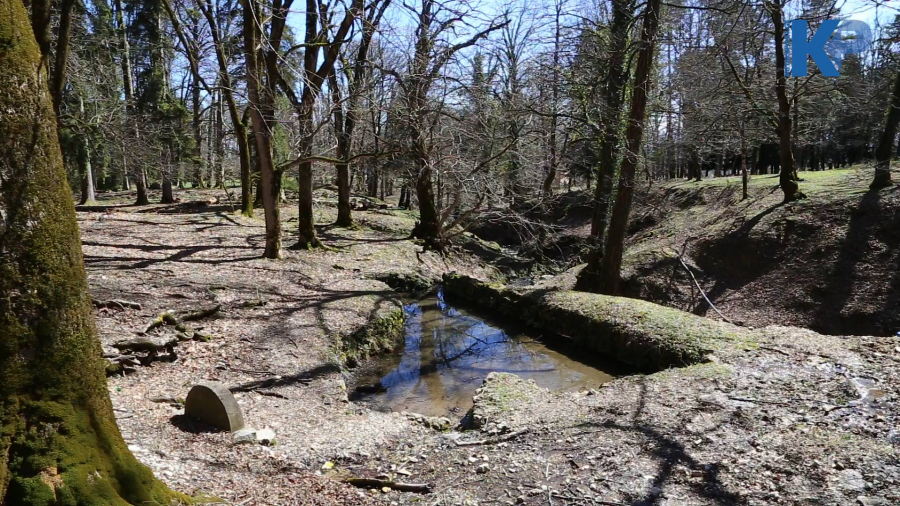Region : Imereti
Municipality : Khoni
Khoni is one of the outstanding and vivid towns of west Georgia. It has always been playing a significant role in the social-economic political and cultural life.
Khoni is situated in lower Imereti, at the bank of Gubistskali and Tskhenistkali affluents of Rioni river. It is situated 266km from Tbilisi city, 28km from Kutaisi city, 19km from Samtredia town, 15km from Tskaltubo town, 15km from Martvili town.
Khoni geographical location is determined by the following data: latitude 42°14' and 42°35', height from sea level is 114 m. The climate is humid subtropical. Winter is mild with average annual temperature +14,3°, annual number of precipitation -1790 mm.
From material-cultural monuments of Khoni it is worse to note saint George church (8th century) -a big sized basilica, three nave basilica type of church without a dome. It consists of Khoni –Samtredia Eparchy.
In the center of the town near Saint George church there is Khoni-Samtredia eparchy residence (in 1996 Khoni returned back its church function-Khoni eparchy has been revived).
Khoni is bejeweled by 19th century developed Boulevard, where the fall of exotic plants and the best recreational place make Khoni locals and city visitors happy.
You can get complete information on the renewed historic museum of Khoni about the city and historical past whole Khoni municipality.
Tradition
“Giorgoba” was a traditional festival for Khoni population which used to take place un May 6 of Spring and November 23 of Autumn. Whole Imereti residents use to gather for this festival. The festival was attended by kings and its noble men. “Giorgoba” festival held in Khoni and Ilori w as outstanding with its magnificence. (right arm of Saint George in buried in Khoni, left arm is in Ilori). The famous publicist Ilia Khoneli wrote: “for Lower Imereti peasant this was a magnificent festival and nothing could compare to it in the whole world. This was not only religious festival but also accompanied with variety of spectacular performances like different sport and creative events.
Since 1998 annually on May 6, on festival “Giorgoba” another public event “Khoneloba” takes place. After the celebrating liturgy many amazing events are held like public stroll in Khoni Boulevard accompanied by famous orchestra’ honorary Khoni citizen is nominated an many, many other events. This day Khoni has many famous visitors, especially those, who live outside Khoni and hurry to native town to celebrate the festival.
- Tourism Potential of Khoni
Interesting tourism attractions are:
- River Tskhenistskali Gorge
Gorge of River Tskhenistskali reached Black sea by one top of the big silkroad through Kutaisi, Khoni, Bumbua bridge and Naqalaqevi. Its one branch was the road of river Tskhenistskali torwards Racha-Lechkhumi and lower Svaneti. (1272 coins of antique age is found close to Khoni , along this road). This important strategic inner road was specially strengthened with fortresses by our ancestors: Unagira (in Khuntsi), Matkhoji fortress, Didghvabuni or lower Gordi fortress, Rekhi fortress, Veli and Metchii fortresses.On the left side of the river there is a Gvashtabi fortress and many other fortresses are dispersed in this area.
The river gorge and historical monuments existed there in this gorge are important from tourism point of view. River Tskhenistkali is very also for small kayaks boating from its beginning until its mouth. The river was used for the same purpose before.
- Askha Mountain
The slopes of a subalpine massive up to 1800meter from seal level, are covered by coniferous forests. Its smoothed hillocks are used for summer pastures, the highest of which –Lekhi is 2449meter long. This part of massive is covered by snow until the first part of June month and can be compared with Gudauri and Bakuriani skiing resorts by its natural conditions. It is 50kilometrs from Kutaisi.
As for Askhi Mountain, it is very perspective by speleological point of view as it is rich with carst caves.
17 caves were discovered in a few kilometers from river Tobi basin, which is full of many stalactites, natural columns. Some of the caves in the bottom have flowing ground water, which the stand as the most beautiful waterfalls above the ground. The caves are connected with a complex system of tunnels with each other and its approximate length reaches to 15 kilometers.
- Canyon of river Okatse
Okatse river flows from Askhi mountain. Its ancient-more than million years old and beautiful canyon is 16metrs long, width in some areas is 10-15 meters long, depth is more than 50 meters. There can be find natural stone bridges (“Stonebridge”). One of them is called a “Boga”, under which the depth of the canyon layer reaches 100meters. The canyon has carst caves from where carst waters are flowing out. Okatse canyon in tectonic fault. The river forms a multi-waterfall, the largest of which is 80 meters, and lakes, whose clear blue-green water is reflected in the white bottom. River Okatse, in Gorda section is arranged by hanging paths, which allows the river landscape to look more browsing. From Visitor’s cabin, path goes through Forest Park, where the ruins of the palace and the church of Dadianis attract our attention.
There are hung paths on the river Okatse area, which enables visitors to look around the landscape. From visitors’ areas, path crosses the Dadiani forest-park where one can see remnants of the palace and look around Dadiani palace church.
- Park covers 50 ha land area
The last chief of Samegrelo region David Dadiani (before 1923 Gordi-Kinchha was included in Senaki district), his wife Catherine Chavchavadze started considerable architectural construction works in 40th of 19th century in this area. Two magnificent palaces were built by Vasilievi architect project. One of them was burnt by rebelled Social Democrats in 1905 (currently second on is also ruined). 15 ha is occupied by a beautiful garden with alleys, church, springs and Swan lake built by foreign decorators.
- Kibula
Kibula is a valley “fenced” by massive rock and sloped down to the west. In the village Kinchkha, where there are here and there artificial layers heightened fortress gate “ Mamukaskari”. here we can find huge remnants of the Hall: “Nadarbazevi”. The north side is strengthened by enormous stone fence. It is still endured clay pipes of the canalization system. Visitors are surprised by seeing the hugeness of the stones of the stone fence.
- Tareshi
Tareshi is the important historical monument in the village Kinchkha. It is the remains of the sublimity of the pagan area, where Christians had left three yew-trees on the name of the holy trinity, having the other ones cut down. One of them is standing. It is the most aged tree in Georgia. There is a spring there and the remains of the oldest church. Also there is a oval built arched semi circled form burial vault (VI-VIII).
- Khocholi
Khocholi is the iron age oldest hill-settlement, where iron fighting weapons and etc was found (these monuments of Kinchkhi is situated closer to the road).
- Satevzia Carst Cave
Satevzia Carst Cave is situated on the left bank of the river Tskhenisktskali, in the village Dzedzileti. It is 7kilometers from “Prometheus” cave (Village Kumistavi, Tskaltubi Municipality).
In 70-80s of last, Speleologists and medics studied the cave and ascertainment its iniquity as a natural monument as well as from medical point of view. In the cave halls there are many stalactites, stalagmites, lakes and etc. “Satevzia” cave requires its thorough studies and tourism infrastructure arranging which will confer it on a status of an important tourism spot.
It should be noted that the cave is situated near Okatse Cave which’s infrastructural arrangements has been started.
- Khoni Cathedral
Khoni Cathedral after Saint George (VIII century) is a three nave basilica type of church without a dome. It is built by modest, white carved stones. It makes one admire to see the cathedral paintings. There are some historic captions and frescos. From preserved deliquesces of the Khone cathedral outstanding is a big miraculous icon after Saint George, which makes art-critics admired.
The left arm of Saint George is buried in Khoni (the left one is in Ilori).
Since 1996, after restoration of the Eparchy again, Saint George Church becomes the Cathedral of Khoni-Samtredia Eparchy.
- Museums
Khoni Historic Museum is located in the city center, d. Guramishvili Street. №3-in. The museum houses dozens of unique monuments, manuscripts and documents. It should be noted three treasures of Kholkhis Tetra, engraved art, bronze and iron-era monuments, rich grave inventory and excellent ethnographical items. There are also theological books survive by museum, Holy Bibles, icons, crosses. Prehistory, the Bronze and Early Iron Ages, feudal era, IX-XX centuries are presented in four large exhibition halls of the Museum. The last hall display life characteristic materials of Khoni area, as well as the countryside Industry. Visitors have the opportunity to obtain comprehensive information on the city and the historical past of the Khoni district and famous Khoni residents.
The museum has three departments: the Museum of Military Glory, Polikarpe Kakabadze and Irakli Abashidze memorials.

Dadiani Forest Park
Show at map
Category : sightseeings

The Dadiani Forest-Park is located in Khoni Municipality, near the Okatse Canyon.
The Forest-Park was laid out by the nobleman of Samegrelo - Davit Dadiani in 1841 and for this purpose he invited an Italian specialist.
There are up to 90 local trees and the forest-park is laid on 7 hectares.
